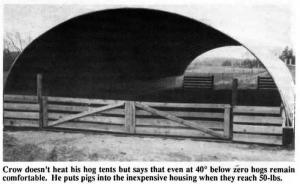1990 - Volume #14, Issue #5, Page #32
[ Sample Stories From This Issue | List of All Stories In This Issue | Print this story
| Read this issue]
Arch Span Tarp Tent For Hogs
 |
Bill Crow, Cambridge, Ontario, feeds 150 hogs inside a 30-ft. wide, 72-ft. long, 11-ft. high "tarp tent" made up of 13 steel arch spans covered by a single tarp made from ultraviolet-resistant, alum in um-coated poly-ethylene. The floor is bedded with straw over an 8 to 10-in. sand base. A large feeder and water bowls are located on a 10-ft. long, 30-ft. wide concrete pad at. one end of the building. Crow uses additional tarp in the winter to close both ends of the building.
"There's nothing fancy about it, but it works and lets me raise hogs cheap," says Crow, who put up a pair of "tarp tents" two years ago and liked them so well that he became the distributor for eastern Canada and recently began advertising in the U.S. "Tarp tents work great for farmers who'd rather finish their feeder pigs than sell them, but can't afford a new finishing barn. They cost about $2.50 per square foot. Conventional hog barns cost $10 to $12 per square foot and deluxe conventional finishing barns cost up to $40 per square foot. I put my pigs in when they weigh about SO lbs. With sand floors, natural ventilation, straw bedding, and lots of room to run around the hogs do very well. I don't try to heat the buildings, but even at 40 below the hogs stay comfort-able especially when I put in extra bedding. The main tarp takes only one day to put up and one day to take down. Small tears are easy to patch up. A replacement tarp would cost about $2,000."
The 2 1/2-in. dia. galvanized steel arch spans are connected by spacers. Each end of the arch span is fitted into a drilled-out 2 by 6 that's nailed to the top of a 6-ft. wood post driven 4 ft. into the ground. The tarp is tied down by a series of ropes strung through eyelets to 2 by 4's that run horizontally along the length of the building and are nailed to the sides of the posts. A 4-ft. high plywood wall protects the sides of the tarp and ropes from curious hogs. A 3-in. air space between the tarp and plywood wall provides ventilation. Gates are located at both ends of the building.
"If I could do it again I'd raise each post another 12 in. so the tarp would overlap more of the plywood wall. The tarp is a trifle short which allows rain to sometimes drip inside," notes Crow, who adds that he plans to build another tarp tent for storing round bales. "I'll, extend the posts 4 ft. above ground to provide a clearance of 15 ft. at the center of the building which will let me stack round bales three high."
Crow spent about $8,000, including concrete pad and feeding and drinking facilities, to build the tarp tent. The tarp tent sells for about $88 per running foot ($100 Canadian). Estimated life is 10 years.
For more information, contact: FARM SHOW Follow up, Bill Crow, RR 2, Cambridge, Ontario, Canada N3C 2V4 (ph 519 822-8559) or in western Canada contact Ron Floyd, Box 216, McCreary, Manitoba, Canada R0J 1B0 (ph 204 835-2495).

Click here to download page story appeared in.

Click here to read entire issue
To read the rest of this story, download this issue below or click here to register with your account number.




